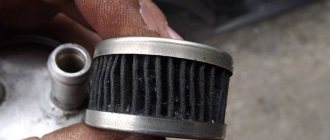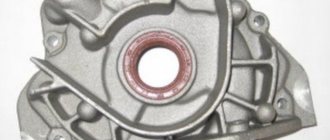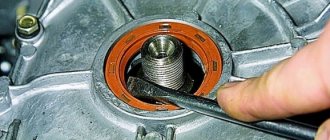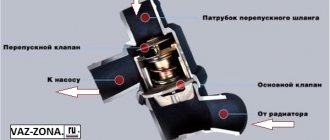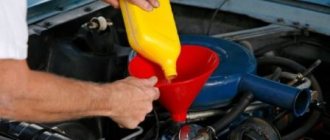Why is the engine knocking?
Among car enthusiasts who are quite far from professional knowledge of the design and physical essence of the operation of automobile units, but due to long-term driving practice, who consider themselves to be great experts on automobile “guts,” there is an opinion that if a knock appears in the engine, then it is the valves that are knocking. In reality, everything is not so simple. One very experienced automobile mechanic told a case that can serve as a clear illustration of incompetence and disrespect for the opinion of a professional.
“A car arrived at the workshop, the owner asked to adjust the valves. When we started the car for diagnostics, a characteristic knocking sound of the connecting rod in the crankshaft was revealed. This is a clear and unambiguous signal for immediate overhaul; there was no question of any valve adjustment; with such an engine it was impossible to even move away. The owner said that all friends and acquaintances and simply knowledgeable people unanimously affirm that this is the knocking of the valves. I was offended by the car mechanics and got into the car, but I couldn’t get far; a connecting rod broke and pierced the cylinder block. The engine had to be changed."
Instructive story. And she reminds you to read your car's owner's manual and listen to the opinions of professionals. In fact, knocking in the VAZ 2114 engine can be caused by several reasons:
- The crankshaft main bearings are knocking. This is usually a metallic thud. Most often it appears at idle when giving gas.
- The connecting rod bearings are knocking. The sound is sharper than when knocking on the main wheels, and also appears at idle. You can determine the location of the sound source by turning off the spark plugs.
- The pistons knock muffledly and quietly. Often simply replacing the pistons or rings will get rid of this sound.
- Valve knocking, inlet or outlet. The frequency of this sound is less than that from the crankshaft and the sound is slightly different, more sonorous. The causes of valve knocking are varied:
— the gaps in the valve mechanisms have increased;
— the valve spring is broken;
— a large gap has formed between the valve and the guide sleeve;
- The cams on the camshaft are worn out.
Diesel, hum, clicks and more: strange car sounds that shouldn’t scare
We have already talked about what engine sounds may hint that he is feeling unwell. Hearing an unfamiliar sound, many begin to worry and worry, and the most suspicious drivers put a Validol tablet under their tongue and go to a car service center. Where, by the way, they often take advantage of their panic and try to repair something that does not need to be repaired. Of course, the appearance of anxiety is the correct reaction. But the machine (and it is still a heap of iron) not only can make noise, but simply must. And some of its sounds should not be scary. Let's see what kind of noise from a car should not make its owner hysterical.
Required Explanation
Before you put one ear to the engine and the other to the gearbox, you need to think about the fact that some sounds have a right to exist on one car, but not on the other. In other words, “dieseling” a Ford or Kia engine are completely different things, and in the first case there is no need to strain, but in the second it is very necessary. Therefore, we will try to discuss such things separately.
The second is a category of sounds, the cause of which is so banal that it is not worth talking about them at all. Such sounds frighten either completely inexperienced drivers, or people who have just changed their car and are not yet accustomed to the fact that it works differently from the previous one. For example, a simple situation: a person in a crisis moved from a foreign car to a VAZ-2115 (ugh three times). I drove all winter, and in the spring I drove for the first time with the window down and suddenly I heard a terrible rumble ahead. And it was just the fan turning on, which was practically inaudible on a foreign car.
Lada Samara (2115) '1997–2012
Or suddenly, at speed, something began to buzz in a recently purchased car. The reason, perhaps, lies in aerodynamics: the side mirrors howled, and on the old “classics” there were drains. This is also too simple and elementary, so we’ll just warn you that there are very simple, loud, but not scary sounds that we won’t talk about. We'll look for something more complicated. Let's start with the engines.
What is good for an American is death for a Korean
Let's start with a light sound that often frightens the car owner - with a barely noticeable clatter. A quiet clattering sound, more like a chirping sound, is the sound of the injectors operating. Whatever they say about the complex design of the nozzle, it is just an electromechanical valve, and it cannot work completely silently. On some engines, the injectors are almost inaudible, while some “slam” noticeably. For example, this sound can often be heard on Korean engines. Of course, there is no need to be afraid of him.
True, if your hearing is not very keen, and you have no experience at all, this noise can be mistaken for a knock in an incorrectly set thermal clearance of the valves. But in fact, the valve clatter is much louder, and, in addition, it usually becomes quieter as the engine warms up (the gap becomes smaller and it does not thrash as much), but the injectors work the same at any temperature. So if the clatter is strong and decreases as it warms up, it’s time to adjust the gaps (or check the hydraulic compensators, if any), and if it is frequent, barely audible and does not change, then there is no need to worry - it’s the injectors that are working.
The second sound is less pleasant and louder. For its characteristic shade it is called “diesel”. Well, a diesel engine always “diesels” - the sound of even a working engine resembles a knock. But running a diesel engine on a gasoline engine can be annoying. But not always.
This phenomenon during a cold start is characteristic of many units, but it is not a sign of their impending demise. As an example, we can cite the engines of the Zetec series, familiar to us from Fords, primarily the 1.6-liter engine with 100 hp. The engine will soon be a hundred years old (okay, okay, a little less), but there is still no exact answer to what is knocking in it.
Most often, the blame is placed on the “pin-piston” connection, in which play appears, and when the piston is moved, a knock appears at the bottom dead center. Short piston skirts are almost as often blamed. Someone is very worried and begins to slowly rebuild the engine or at least adjust the valve clearance (this engine does not have hydraulic compensators). Adjusting the valves has never hurt anyone, but it doesn’t get rid of diesel. And since with this knocking “zeteki” quietly drive for 400 thousand kilometers, diesel engine was recognized as a “design feature” that does not affect the resource in any way.
I note that I myself had a first-generation Focus with such an engine, but with a volume of two liters. It drove without repair until it covered 420 thousand kilometers, was sold with a handwritten contract to Moscow, after which I received fines for another year from Chuvashia, Udmurtia and Tatarstan. Apparently, 420 thousand is far from the limit for a diesel Zetec, and I had to stop registering this car with the traffic police. By the way, there was no “oil burn” during this run. Therefore, if the car’s engine is one of those that has the right to run a little diesel after a cold start, you shouldn’t worry about it. Yes, this is rather an exception, but it exists.
In addition to Zetec motors, this includes motors of the EA111 series - CFNA and CFNB. There the situation is a little more complicated: sometimes the knocking is caused by wear of the piston group, leading to a decent amount of oil leakage. And at the same time, for many, simple 1.6-liter engines with multipoint injection knock on for tens of thousands of kilometers without falling apart or suffering from other “diseases”. The main thing is not to confuse this sound with the knocking of the timing chain. You still have to change the chain.
Although there is an exception here too. For example, the Opel Z12XEL engine produced before 2010. The cause of its characteristic “dieseling” is precisely the chain, but there is nothing terrible: it is enough to replace the not very successful hydraulic tensioner. The chain and gears themselves last a long time, but the efficiency of the tensioner turned out to be insufficient. It was replaced in 2010 and the problem went away. Therefore, if you hear a strange sound from under the hood, for example, of your Opel Corsa D, do not rush to change the entire timing chain drive: very often the reason is much cheaper and simpler. So it’s too early to panic, you need to look for a good specialist.
What to do if valves are knocking
Extraneous noise in the engine appears most often on cars that the owners do not take care of, and if they do, it is from time to time, and the breaks in these cases are usually very long. An illustration of this can be an analysis of the reasons why valves knock.
The most common reason is increased clearance between the arms and the camshaft cams. And this reason can be eliminated simply by adjusting the valves. And, again, an elementary thing that every driver should know - the valves must be adjusted every fifteen thousand kilometers. This is a mandatory rule.
Careless drivers have had cases when they remembered the valves after 70 thousand miles, and then the car mechanic could not do anything with them, they could not be adjusted.
Car owners often worry about valve knocking on a cold engine. That is, when the engine is cold, there is a clear knocking sound, but as the engine warms up, these sounds disappear. Experienced automobile mechanics explain this by saying that on a car with a fairly high mileage, parts wear out, and this especially happens with parts of the power plant. Small gaps appear between them, which generally do not affect the operation of the systems for the worse, but manifest themselves in a cold state. It is because of these resulting gaps that such annoying sounds appear for drivers. When heated, the metal expands, the gaps disappear, and along with this the unpleasant sound disappears.
However, this does not mean that one should be indifferent to extraneous noise in the engine when it is cold, especially if the owner monitors the timeliness of all adjustments. After all, on a cold engine, at idle speed, the main or connecting rod bearings of the crankshaft can make noise, and this is already very serious. You should definitely contact a specialist for diagnosis.
Every driver heard the valves knocking when hot. Especially with a sharp increase in speed. The most common reason for this is low-quality gasoline. But there may be other reasons, for example, a knock sensor has failed. Or the oil pressure has dropped.
In addition to increasing the clearance, the causes of noise produced by valves can be:
- wear of the camshaft cams - in this case it is necessary to replace the entire camshaft;
- valve spring failure - if this is detected, a new spring must be installed;
- the guide bushing may need to be adjusted or replaced;
- Valve knocking can be caused by completely different reasons, for example, a poorly tensioned timing belt or poor flow of oil through the camshaft to the fingers due to clogged channels in the valve.
It is very difficult for an inexperienced person to determine by ear that the valves on a VAZ 2114 are knocking. Nevertheless, experts recommend some folk remedies, recalling that the camshaft rotates twice as slow as the crankshaft and, accordingly, the sound of the valves should not be frequent. For better sound perception, they suggest placing an empty metal mug to your ear and placing it on the hood. In this case, the sound becomes clear and easy to hear.
When operating a car, the driver must remember that extraneous noise in the engine can be avoided by constantly monitoring the condition of all systems, promptly replacing spare parts that have been used under warranty, and making all necessary adjustments.
An attentive and experienced driver always listens to the sounds of his car. If an unfamiliar knock, noise, or clanging appears in the engine, he will immediately try to determine the cause and nature of this phenomenon. If there is something knocking under the hood, this is a signal of one or another malfunction of the car, which can come out - in the literal sense of the word.
Valve knocking: main reasons
At the very beginning, we note that valve knocking is a problem that is more typical of engines without hydraulic compensators. In other words, these elements can knock on engines that structurally require the need to adjust the valves at a certain frequency. As for engines that are equipped with hydraulic compensators, in units of this type it is often not the valves themselves that knock, but the compensators mentioned above.
We also recommend reading the article about what a hydraulic compensator is. From this article you will learn about the design of this element, as well as how hydraulic compensators work to automatically adjust the valve clearance.
Valve knocking usually appears on engines in two cases:
- natural wear and tear of the power unit as a result of impressive mileage;
- the valves are not adjusted or this procedure was performed incorrectly;
In other words, the mechanism can knock both on an old engine and on a relatively new engine that has only traveled a few tens of thousands of km. The main reason for this knocking is a strong increase in the gap that is present between the camshaft cam and the lever. An increased gap between these elements means that the camshaft cam hits the rocker. The result is a general increase in noise during operation of the engine and timing belt; the engine runs “hard”. The appearance of a distinct ringing metallic sound was also noted, which is clearly audible and localized in the area of the cylinder head and valve cover.
It should be understood that the valve thermal clearances initially set at the factory tend to get lost after several tens of thousands of kilometers traveled. It is for this reason that the owner needs to adjust these gaps from time to time. The setting is carried out taking into account a strictly defined value for a specific type and model of engine, which is prescribed in the operating instructions for a particular vehicle.
Let us immediately note that the generally accepted recommendation for valve adjustment intervals is a mileage of 15-20 thousand km. Before making adjustments, especially on older engines, it is necessary to eliminate the possibility of problems with oil pressure in the lubrication system. The gap adjustment itself is carried out using feeler gauges. These probes are inserted into the slot, which is located between the pusher and the cam on engines with an overhead camshaft. On other types of motors, the gap is located between the upper edge of the rod and the rocker arm. When setting the gaps, it is also advisable to take into account the outside air temperature. The valves are optimally adjusted at a temperature of +20 degrees Celsius. If adjustments occur, for example, at negative temperatures, then this nuance should be taken into account and a certain correction should be made for it.
Reducing the gap (the valves are clamped) is also unacceptable. The fact is that in the case of clamped valves, the following happens: after a relatively short run, they stop closing completely. If these elements cannot close completely, then the compression in the cylinders drops due to depressurization of the combustion chamber, hot gases break through the gap between the valve and the chamfer, engine overheating, valve burnout, etc. occurs. In this case, the engine starts poorly, loses power, consumes too much fuel, suffers from trouble, etc. The result is the impossibility of further normal operation of the internal combustion engine and the need to eliminate both the problem itself and the likely consequences of driving with clamped valves. Please note that the degree of increase or decrease in the gap directly affects the wear of not only the timing belt, but also the entire engine. Long-term operation of the power unit with obvious knocking in the gas distribution mechanism leads to serious damage and rapid failure of the entire power unit.
We also recommend reading the article on how to determine valve burnout yourself. From this article you will learn by what signs and in what ways you can find out that the timing valve has burned out.
The most reliable passenger engines: TOP-10
Mobil Super 3000 5W40 engine oil: benefits and…
Is knocking dangerous?
What can a knock in the transmission or power unit of a car indicate? That somewhere the fastening of a part, assembly or unit has become loose. It is possible that the gap in the mating of moving parts has increased. Or it may be that when the brake pads in the car are extremely worn, a grinding and whistling sound appears when braking. Or that when the battery is discharged or the alternator belt is weak and there is a heavy load in the car’s electrical network, a sharp whistle appears in the alternator bearings. Let's summarize briefly: extraneous sounds, noises, rattles are the result of wear and tear on parts, components and assemblies of cars. Nothing like this can happen to a new, high-quality car.
How to Find a Noisy Valve Trim
On some cars, removing the valve cover to find a noisy lifter isn't that difficult. You can use a mechanic's stethoscope to determine the problem, but a piece of rubber hose may also work fine.
- Remove the cover.
- Set the parking brake and transmission to neutral (manual) or park (automatic).
- Start the engine and let it idle.
- Place one end of the hose against your ear and the other end over the spring area of each valve.
- A noisy lifter will sound louder when you put a hose on a valve with a faulty lifter.
You can use this method to find valve noises also coming from a specific cylinder.
Rockers can also suffer from lack of oil.
The main sources of extraneous sounds in the engine
You must understand that not every extraneous sound is a signal of engine malfunction. This primarily concerns knocking noises in the outer parts of the engine. But everyone has a reason that must be found. For example, the flagellum that holds together the bundle of electrical wires has broken. The wires fell apart and when the engine was running, some of them began to muffledly hit some surface. Will this lead to serious consequences? At first, no. If measures are not taken, then after a long time the insulation on the wire will wear out and a short circuit may occur, which, through the combustion of a fuse, will de-energize some part of the on-board network. Parts that have loose fastening bolts often knock. This is also an unpleasant, but not critical situation. It is enough to take the keys and tighten the loose threaded connections yourself.
Types of extraneous noise in the power unit
Here are the most common extraneous sounds in the engine that should alert the car owner:
Hissing . This specific sound under the hood of the car while the engine is running may indicate air leaks in depressurized vacuum systems or in the cooling system. The consequences can be severe. In the first case, the brake system may fail, in the second, the engine may overheat due to an antifreeze leak. Therefore, you urgently need to go to a car service center to diagnose and eliminate the cause of the hissing sound.
A squealing or sharp whistling sound most likely indicates a weakened drive belt of some component: timing belt, generator, water pump, air conditioning compressor. The belt begins to slip in the drive pulleys and at the same time emit a characteristic squeal. If timely measures are not taken, the belt may break with unpleasant consequences.
Knocks of different tones inside the engine in the area of the crankshaft, pistons, and valves give rise to diagnosing the operation of the engine as a whole to identify the cause of extraneous sounds. Unusual knocking inside the engine is a cause for the most serious concern. Their appearance may signal the possible high costs of eliminating them. If the liner rattles, you will need to disassemble the engine with grooving or even replacing the crankshaft. A knocking sound appeared in the middle of the block - the connecting rod and piston group was worn out. You will need to completely disassemble the engine, bore the cylinder block, change pistons, rings, pins. If the sound is clearly audible in the upper part, then perhaps the valves need to be adjusted, or perhaps the piston reaches the cylinder head due to a large gap in the connecting rod bearings.
Reasons for the appearance of extraneous sounds in the engine
The reasons and circumstances under which knocking appeared are different. Extraneous noise can be clearly heard both outside the engine and inside it. Internal ones are more dangerous than external ones. The cylinder block contains the crankshaft, pistons, connecting rods, and parts of the gas distribution mechanism. If the knocking comes from this group of mechanisms, then this is always associated with partial or complete disassembly of the engine to eliminate the malfunction. Often the sounds are sharp in nature, which intensifies when the throttle is opened smoothly. If the sounds are loud, with a “light tinkling” of iron and appear with a rapid increase in the speed of rotation of the flywheel, then this indicates detonation - a violation of the fuel ignition regime.
Video: Mercedes 126, found the cause of the knocking in the engine
Knocks from detonation
If the knocking is strong with a ringing “metallic” tint and occurs when the gas pedal is sharply pressed, or under load, then this is the result of detonation - explosive combustion of fuel in the cylinders. Moreover, detonation occurs differently in different types of engines. Gasoline engines have the expression “knocking fingers.” This is not entirely correct. In fact, during abnormal fuel combustion, the piston skirt knocks when it passes top dead center. Gasoline detonation is the result of refueling with poor fuel with a low octane rating, incorrect valve timing adjustment, and prolonged engine operation in an overheated state. To eliminate detonation, it is enough to cool the engine, adjust the fuel injection and ignition systems, and fill the tank with gasoline in accordance with the technical regulations of the car.
Diesels also have fuel detonation, but their reason for its formation is different. This is an early injection of diesel fuel or a lean fuel mixture, which arises from improper operation of the pressure valve in the high-pressure fuel pump (HPF). Moreover, the sound will be loud, ringing, similar to the blows of a piston on the surface of the cylinder head. In such cases, they say that the diesel engine operates “hard”. This impression arises because the compression ratio of diesel engines is much higher than that of gasoline engines, so in normal operating condition the distance between the piston and the block head is microscopic. You can get rid of detonation by restoring the operation of the pressure valve on a special stand in a service station.
Even in diesel engines, at idle speed, the knocking of the plungers is clearly audible. This is a design feature of almost all engines of this type. These sounds do not pose any threat. Diesel engines have been used with them for more than one year. In engines with gasoline injection, an experienced ear hears the “clicks” of fuel injectors, which are also inherent in most engines of this type. They do not pose any serious threat to the engine, and in no way affect its performance characteristics.
4g63 Engine On Which Cars
The Mitsubishi 4g63 engine is a four-cylinder engine designed for installation in passenger cars. It was first introduced in 1975 on vehicles such as the Mitsubishi Galant and Lambda. Then it bore the name G62B, after which G63B appeared. Unlike its predecessor, it had a larger displacement, a different diameter of the cylinders and a different casting on the block.
In 1980, a new version of the engine appeared, including a mono-injection engine, also turbocharging and 12 valves. It was mounted on passenger cars, specifically Lancer EX2000 and Galant Lambda.
The next step in development came in 1984, when an inverter version of the motor, equipped with 8 valves, was introduced. After 1988, the engine series was renamed and the new version became known as 4g63.
Compared to its predecessors, it had increased power and caused less harm to the environment.
In 1993, significant changes occurred in the design. A modification appeared that had a unique method of attaching the flywheel to the crankshaft with 7 bolts. Along with the newest one, an ancient version with 6 mounting bolts was produced. Throughout its history, the engine has been manufactured by Mitsubishi MOTORS.
Tightening global environmental standards has led to the end of production of 8-valve versions of the engine. The last modification, equipped with an injector, was assembled in 1993.
A similar version of the engine with a carburetor remained in mass production longer, thanks to its highest reliability and low cost.
In 1995, a modification with a 7-bolt fastening became known as 4g63T. By the end of 1997, the 6-bolt version of the engine with injection and turbocharging was completely discontinued. In 2003, the engine received a number of improvements and began to be supplemented with the MIVEC system.
Specifications
The Mitsubishi 4g63 engine is now one of the most popular four-cylinder in-line internal combustion engines. It has a number of technical features:
- Weight is 160 kg.
- Cast iron is used in the production of cylinders.
- The power system is of the carburetor or injection variety.
- Engine power reaches 109 horsepower at 5500 rpm.
- The number of cylinders is four.
- There are 2 valves per cylinder.
- The piston stroke is 88 mm.
- The diameter of the cylinder is 85 mm.
- 95 gasoline is used as fuel.
- Fuel consumption reaches 13.9 liters per 100 km when we are talking about mixed cycle operation.
- An oil change is done every 10,000 km.
- The engine life is 200,000 km, according to the manufacturer’s information, but in practice this figure can more than double with proper care.
- The unit has appropriate features, for example, it contains two balancing shafts installed in antiphase. Thanks to them, vibrations that occur during operation at high speeds are virtually completely eliminated.
- The 4g63 engine can be mounted on vehicles that provide for both longitudinal and transverse installation of the unit. This feature makes it possible to use the engine not only on full-size sedans, but also on small cars designed for driving in urban areas.
- The engine number is located on the left side under the exhaust manifold. To see it, you have to use a mirror.
4g63 Engine On Which Cars
Over the years of its existence, the unit has established itself as a reliable and long-lasting element of the car, regardless of the presence of turbocharging, single injection or injector.
Modifications
As mentioned above, over the years of its existence, the 4g63 motor was improved and produced in various modifications, for example:
- 4g63T, the peculiarity of which was the presence of turbocharging and a system that included 12 valves. It had fairly high reliability and durability characteristics, but was not widely used due to problems with the turbine used. It was often mounted on sports vehicles. The unit could produce up to 300 horsepower, which provided the cars with the highest dynamics.
- It appeared in 1986 and used a gas distribution system called DOHC. Its presence made it possible to improve the power properties of the motor. This version fully complied with the strict requirements of Japanese environmental legislation.
- 4g63 with 4 valves on one cylinder. This version was equipped with a modified gas distribution system called SOHS. The distinctive features of this variety were the highest dynamic characteristics and low fuel consumption.
- 4g64 appeared in 1993 and included a flywheel mounted with 7 bolts. The corresponding features of this modification are improved injection and a fuel injection system of the injection variety. Some Chinese manufacturers continue to install the 4g63 engine on their cars even now.
ENGINE KNOCKING IN FRONT WHEEL VAZ CARS
In front-wheel drive VAZ cars, the engines may have different digital indices, since the engines are installed on different car models. But basically all power units have the same circuit diagram, but they may differ:
- 8-valve or 16-valve cylinder head;
- Piston diameter;
- Carburetor or injection fuel system;
- Minor design features (different sensors, collector configuration, etc.).
In particular, the VAZ 2114 car is equipped with an 8-valve 4-cylinder engine with a volume of 1.5 liters of the VAZ 2111 model, with a fuel supply system of the “injector” type (distributed injection). Exactly the same internal combustion engine (ICE) is equipped with the VAZ 2115 and VAZ 2113.
Various knocking noises can occur in an internal combustion engine, and it is not necessarily the valves that are knocking. Knocks can occur:
- In the piston group,
- In the crank mechanism;
- In the gas distribution system;
- In attachments (water pump, generator, etc.).
Why does the engine knock, what could be causing the knocking:
- insufficient amount of oil in the oil system crankcase;
- wear of parts due to long-term use;
- manufacturing defects;
- engine overheating;
- operation of the motor at constant maximum loads.
Knocking in the VAZ 2114 engine has a different character; determining the cause is sometimes difficult even for technicians who have some experience in repairs. But there are characteristic sounds that are identified quite easily:
- a sharp “dry” metallic sound, clearly audible when you sharply press the gas pedal. This is how the crankpins (bearings) of the crankshaft knock. This is a serious knock, at a minimum, it requires crankshaft grinding;
- the sound is medium in tone; when the speed increases, it seems that something is rolling around inside the internal combustion engine. This is how the pistons usually knock;
- single clicking sound. As the speed increases, it seems to merge, and is similar to the sound of a working sewing machine. This is how parts of the gas distribution mechanism (camshaft, pusher) usually knock.
How do valves knock, how to determine it? The valve knock is usually quite sharp, clicking, and high-pitched. He can knock not just one, but several at once. To understand the cause of various noises in the gas distribution mechanism (GRM), you need to have at least a little idea of its structure. The VAZ 2114 timing belt consists of the following elements:
- camshaft.
- timing gear.
- Timing belt.
- Pushers.
- Adjusting washers.
- Inlet and exhaust valves.
Basically the scheme works as follows:
- From the rotating crankshaft, movement is transmitted through the timing belt to the camshaft gear;
- The gear is rigidly fixed to the camshaft (fixed with a key and secured with a bolt), so the shaft is also driven;
- The camshaft cams press on the adjusting washer located in the outer part of the bottom of the pusher.
- The pusher presses the valve, the valve opens and closes when the crankshaft moves, the working mixture is filled into the internal combustion engine cylinders, and the working cycle is completed.
The cause of the knock can be any link in the gas distribution mechanism. But there are the most common reasons:
- Large gap between the camshaft cam and the pusher;
- Wear of camshaft bearings;
- Wear of the seat in the cylinder head (cylinder head) under the camshaft;
- Worn uneven surface of the adjusting washer;
- Breaking of the seat for the pusher in the cylinder head.
Engine repair tips
If a distinct knocking sound appears in the engine, be sure to check the engine oil level; its drop in the lubrication system can lead to malfunction of the entire internal combustion engine system. If the level is optimal, determine where the sound is located. At this stage, you need to make sure that the following are in working order:
- fuel system;
- drives;
- attachment pulleys.
The next step is to determine the characteristics of the knock. If a “loaded” engine knocks more strongly, most likely, problems have appeared in the crank mechanism or in the cylinder-piston group.
If you notice that the knocking frequency does not coincide with the crankshaft rotation speed (it differs by about 2 times), then the probable problem must be looked for in the timing system. The fact is that the crankshaft rotation speed is 2 times higher than the camshaft rotation speed. When the engine warms up, the knocking noise usually gets worse because the clearances in the valve mechanism become larger as the engine heats up. The gas distribution mechanism, on the contrary, is not related to the operating mode of the engine. As an exception, we can recall cases of hydraulic compensators knocking under load.
Increased knocking can also occur due to heating and subsequent expansion of the engine oil, which indicates a problem with the bearings of the crankshaft mechanism.
The specialists of the official FAVORIT MOTORS service center will help you troubleshoot any engine design. The experience and professional knowledge of our specialists can quickly and inexpensively return your vehicle to good condition using original spare parts, consumables and modern equipment. All work is carried out with a guarantee and in accordance with the manufacturers' recommendations.
ADJUSTMENT
In any case, if a characteristic valve knock occurs in the engine, it is necessary to check the condition of the valves. In this case, adjustments should be made. To adjust the valves of the VAZ 2114, factory-made adjusting washers with a thickness of 3 to 4.5 millimeters are provided, the thickness changes every 0.05 mm. We make the adjustment as follows (you will need a special shim remover and washers themselves of varying thickness):
- Disconnect the throttle cable bracket from the valve cover;
- Remove the valve cover (two bolts);
- We dismantle the timing belt casing;
- We set the top dead center in the first cylinder of the internal combustion engine (there is a mark on the timing gear). How to align the marks can be found in the repair and operation manual. You can turn the camshaft clockwise using the camshaft bolt. But this must be done carefully and without unnecessary effort;
- We check the gap with a set of automotive feeler gauges between the pusher and camshaft cams 1 and 3 valves according to the timing belt. The intake valve should have clearance
0.2 mm, at graduation it is larger on average
0.35 mm;
- We remove the adjusting washer and look at the markings (thickness is indicated in three numbers). Using mathematical calculations, we determine the required thickness to adjust the gap and install the new washer in place. We immediately check the resulting gap;
- We turn the camshaft a quarter turn clockwise and adjust valves 2 and 5. After another quarter - 6 and 8, the last ones to adjust are valves 4 and 7, also after ¼ turn.
- After adjustment, we put everything back together in the reverse order, start and listen to the engine.
My engine has no power
Timing belt problems:
The most common timing belt failure is a belt failure due to extended life or failure of the associated component.
However, a worn timing belt can also stretch too much, or a faulty component can cause the belt to skip a sprocket tooth. These problems can cause engine performance problems such as:
- Engine knock
- Increased fuel consumption
- Ignition delay
- Loss of engine power
If you have a broken timing belt it can cause damage to your engine. The best preventive measure is to replace the belt at the interval recommended by the manufacturer.
Timing circuit problems:
A worn timing chain is not common, but it can happen on high mileage engines. However, some timing chain assemblies use a hydraulic tensioner and nylon guides.
For a hydraulic tensioner or guide, problems are most often caused by dirty oil, low oil, or low pressure in the system. Although low pressure can also cause noise along the valve row. Additionally, the guides may become worn to the point that the tensioner cannot keep the chain tight.
Any of these problems will cause the chain to become slack between the camshaft and the crankshaft sprockets. In addition to the rattling noise, this will disrupt the timing of the valves and pistons and cause a loss of engine power.
How to Check for Slack in the Timing Chain
In addition to diagnosing the rattling noise coming from the front engine cover, you can perform the following check.
For this test, you will need to remove the valve cover to access the valve block, or if your model has a distributor, remove the distributor cap.
- If your vehicle has a distributor, remove the distributor cap; otherwise, remove the valve cover.
- Remove the spark plugs to make it easier to turn the crankshaft if necessary.
- Using the appropriate size socket and jumper, rotate the crankshaft back and forth a few degrees using the crankshaft bolt at the front of the engine.
- If the crankshaft rotates several degrees without moving the rotor or distributor valve, the timing chain, hydraulic tensioner, or guide is faulty.
A broken timing belt can cause serious damage such as bent valves.
OTHER POSSIBLE TIMING KNOCKS
What should I do if the valves are knocking even after the adjustment has been carried out correctly? In this case, it is necessary to check the condition of the pushers and the camshaft. To do this, remove the camshaft and check:
Many VAZ owners are concerned about valve knocking on a cold engine. But the valves knock the same way both on “cold” and “hot”. There are no rods in the timing belt of VAZ engines, as in some GAZ and UAZ engines, so the gap on 2114 practically does not change with heating.
Most likely, the knocking when cold is not due to the valves, but due to the increased gap between the pistons and the cylinder walls in the piston group.
Aluminum pistons expand as they warm up and the clearance decreases. Accordingly, the knocking disappears.
Posts 6
1 Topic by maximmus1 2014-12-07 19:59:46 (2014-12-07 20:01:22 edited by maximmus1)
- maximmus1
- New member
- Inactive
- Registration: 2014-12-07
- Messages: 2 Thanks : 0
- Car: VAZ 21112
Topic: Why is the engine loud, like a diesel engine?
Hello everyone, I have the same problem, the engine runs like a diesel engine, previously it only rattled when it was cold when you were accelerating, but now it’s constantly, the mechanic says that the sound is coming from the suction manifold, it’s like plastic and has swirls! Has anyone encountered this?
2 Reply from Serg 2014-12-08 10:24:24 (2014-12-08 10:27:28 edited by Serg)
- Serg
- Lada2111.rf fan
- Inactive
- Registration: 2013-07-29
- Messages: 830 Thanks : 363
- Car: 2111 dwg 2114 year 2008
PERIODICITY OF ADJUSTING VAZ 2114 VALVES
Car owners have a question: how often is it necessary to adjust the valves on a VAZ 2114 if they do not knock, and is it necessary to make adjustments in this case? According to the factory settings, the valves should be adjusted every 20 thousand km during vehicle operation.
Why carry out adjustment work if the valves of the VAZ 2114 do not knock? The fact is that over time, seat saddles wear out over time. The valve becomes higher and the clearance decreases. And too small a gap threatens loss of power and burnout of the exhaust valves. Before the due date, the clearance in the valves should be checked if knocking occurs and if it is suspected that they are clamped.
How to understand that the spark plugs are faulty?
There are three main reasons that cause ignition system malfunctions:
- late or early ignition;
- misfire in one or more cylinders;
- complete shutdown of ignition.
Late ignition
characterized by loss of power and overheating of the engine,
early
- also loss of power, knocking in the engine and increased fuel consumption.
Ignition faults
in one or more cylinders are most often caused by a faulty spark plug, deterioration of the insulation of the high voltage wire connected to the spark plug, as well as poor contact of this wire in the tip of the spark plug or ignition coil.
To direct spark plug faults
relate:
- spark plug insulator cracks;
- burning of electrodes or change in the gap between them;
- carbon deposits on the electrodes.
A special check will help you understand that the problem is in the spark plugs. This simple procedure does not require special equipment. All you need is a spark plug, free time and your undivided attention.


